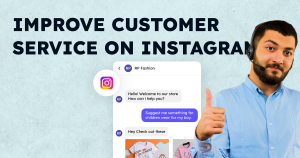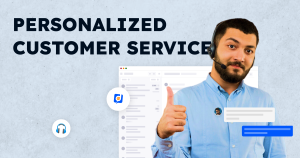The Importance of Customer Loyalty for Your Business
Customer loyalty is important for any business, big or small. It’s a reflection of how satisfied your customers are with your products or services, and how likely they are to continue doing business with you in the future. Building customer loyalty isn’t something that happens overnight, it’s a long-term strategy that requires consistent effort and dedication.
Here are some reasons why customer loyalty is so important for your business:
Key Takeaway :
Building customer loyalty and trust in 2024 requires consistent effort and dedication. Businesses can cultivate strong relationships with customers by providing exceptional customer service, personalized experiences, valuable rewards, and implementing loyalty programs. It’s important to measure customer loyalty over time and use customer data to make informed decisions on how to improve loyalty. By prioritizing customer loyalty, businesses can lower customer acquisition costs, retain existing customers, and make customers loyal only to their brand.
1. Increase in Customer Retention
Acquiring new customers can be costly, so it’s important to retain the ones you already have. Studies have shown that increasing customer retention rates by just 5% can increase profits by 25-95%. When your customers are loyal, they are more likely to continue doing business with you, leading to a higher customer lifetime value and a more stable revenue stream.
2. Boost Customer Advocacy
Loyal customers are not only more likely to continue doing business with you, but they are also more likely to recommend your business to others. They become advocates for your brand, promoting it to their friends and family through word-of-mouth marketing. This can lead to a significant increase in customer acquisition without any additional cost to your business.
3. Greater Understanding of Customer Needs
When you build relationships with your customers, you gain a deeper understanding of their needs and preferences. This allows you to create products and services that are tailored to their specific needs, leading to greater customer satisfaction and loyalty over time.
4. Successful Loyalty Program Implementation
Implementing a successful loyalty program can help you build customer loyalty by incentivizing your customers to continue doing business with you. Tiered loyalty programs are especially effective because they encourage customers to move up the loyalty ladder, unlocking greater rewards and benefits as they do so.
5. Excellent Customer Service
Providing great customer service is one of the most effective ways to build customer loyalty. When your customers feel valued and appreciated, they are more likely to return to your business. This can be achieved through customer success teams, customer relationship management, and investing in building customer loyalty over time.
In summary, customer loyalty is critical to the success of any business. It’s important to track customer behavior and measure loyalty over time to promote customer loyalty and move customers up the loyalty ladder. By cultivating a great relationship with your customers and providing excellent customer service, you can build trust and loyalty to your business, and ultimately increase your customer lifetime value.
Strategies to Build and Improve Customer Loyalty for Your Brand
Customer feedback is a valuable tool for improving customer experience and building a loyal customer base. By actively seeking and listening to feedback from your customers, you can gain insights into what works and what needs improvement in your business. This, in turn, allows you to make data-driven decisions to improve your products, services, and overall customer experience.
Here are some ways to utilize customer feedback to increase customer loyalty:
-
Collect feedback through surveys, social media, reviews, and other channels. Make sure to ask specific questions that will provide you with actionable insights.
-
Analyze customer feedback to identify areas for improvement. Look for patterns and common themes in the feedback to see where your business can improve.
-
Use feedback to make changes and improvements to your products, services, and customer experience. Take action on the feedback you receive to show your customers that you are actively listening and working to improve.
-
Implement a reward program for repeat customers and referrals. By rewarding customers for their loyalty and advocacy, you can encourage repeat business and referrals.
-
Use customer feedback as a metric to measure customer loyalty over time. By tracking changes in customer feedback, you can see if your efforts to improve customer experience are having a positive impact on customer loyalty.
For example, a clothing store may receive feedback from customers that their website is difficult to navigate and that shipping times are too long. After analyzing this feedback, the store could make improvements to its website and shipping processes to better meet customer needs. They could also implement a reward program for repeat customers, such as offering discounts or free shipping for frequent shoppers.
By taking action on customer feedback and implementing a loyalty program, the clothing store can improve customer experience and increase customer loyalty.
In conclusion, utilizing customer feedback is an important aspect of any customer loyalty strategy. By actively seeking and implementing feedback, businesses can improve their products and services, retain customers, and build a loyal customer base.
Measuring Customer Loyalty: How to Know if Your Efforts Are Working
 Customer loyalty is important for any business that wants to succeed in the long term. Building a loyal customer base takes time and effort, but it’s worth it when you consider the benefits. A loyal customer is more likely to recommend your business to others, spend more money on your products or services, and provide valuable feedback that can help you improve your offerings. But how do you know if your efforts to build customer loyalty are working? Here are some tips on measuring customer loyalty:
Customer loyalty is important for any business that wants to succeed in the long term. Building a loyal customer base takes time and effort, but it’s worth it when you consider the benefits. A loyal customer is more likely to recommend your business to others, spend more money on your products or services, and provide valuable feedback that can help you improve your offerings. But how do you know if your efforts to build customer loyalty are working? Here are some tips on measuring customer loyalty:
Use a Customer Loyalty Metric:
There are several metrics you can use to measure customer loyalty, such as Net Promoter Score (NPS), Customer Satisfaction (CSAT), and Customer Effort Score (CES). These metrics can help you understand how your customers perceive your business and how likely they are to recommend you to others.
Analyze Customer Data:
Collecting and analyzing customer data can provide valuable insights into customer behavior and loyalty. Look at metrics such as customer lifetime value (CLV) and customer retention rate to understand how often customers are returning to your business and how much they are spending.
Monitor Repeat Business and Referrals:
Repeat business and referrals are good indications of customer loyalty. If you see a high percentage of repeat business or customers referring others to your business, it’s a sign that your efforts to build loyalty are working.
Implement a Referral Program:
Referral programs can be a great way to encourage customer loyalty and measure its effectiveness. By offering rewards or incentives for customers who refer others to your business, you can see how many customers are willing to recommend you to their network.
Gather Customer Feedback:
Customer feedback can help you understand what you’re doing well and what you need to improve. Use surveys, feedback forms, and social media to gather feedback from your customers and make improvements based on their suggestions.
By using these tips, you can measure the effectiveness of your customer loyalty strategies and make improvements as needed to build a strong and loyal customer base. Remember, customer loyalty is not just about making a sale – it’s about cultivating a relationship with your customers and providing a positive customer experience that will make them want to come back again and again.
Types of Customer Loyalty Programs: Which One is Right for Your Business?

When it comes to building customer loyalty, one of the most effective ways is through loyalty programs. These programs offer incentives and rewards to customers who make repeat purchases or engage with a business in other meaningful ways. But with so many different types of loyalty programs out there, how do you know which one is right for your business?
Here are some common types of customer loyalty programs to consider:
1. Points-Based Program:
This is perhaps the most common type of loyalty program, where customers earn points for purchases or other actions, which can then be redeemed for rewards like discounts, free products, or other benefits.
2. Tiered Program:
This program rewards customers based on their level of engagement. As customers move up the loyalty ladder by making more purchases or engaging more with the business, they unlock more exclusive benefits.
3. Cash-Back Program:
This program rewards customers with a percentage of their spending back in the form of cash or store credit, which they can then use for future purchases.
4. Paid Program:
Some loyalty programs require customers to pay a membership fee to access exclusive benefits, such as free shipping, early access to new products, or other perks.
5. Coalition Program:
In this type of program, businesses partner with other non-competing businesses to offer a shared loyalty program. Customers can earn and redeem rewards across all the participating businesses.
When choosing the right loyalty program for your business, consider factors such as your customer base, your industry, and your budget. You may also want to test different programs to see what resonates most with your customers.
Remember, a successful loyalty program is not just about the rewards, but also about fostering a strong relationship with your customers. Be sure to communicate clearly with your customers about the program, engage with them regularly, and always prioritize their needs and preferences.
Encouraging Customer Loyalty: Tips and Techniques to Keep Customers Coming Back
Provide Excellent Customer Service:

Make sure your customers feel valued and appreciated by offering them exceptional service. Respond to their queries and complaints promptly, and go the extra mile to solve their problems.
Create a Loyalty Program:
Reward customers for their loyalty with a tiered loyalty program that offers different levels of rewards based on their level of engagement with your brand. This could include discounts, free products, or exclusive access to new products or services.
Personalize The Customer Experience:
Use customer data to personalize the customer experience by tailoring your marketing and communication to their specific needs and preferences.
Listen to Customer Feedback:
Encourage customers to provide feedback, and use it to improve your products and services. This shows that you value their opinions and are committed to providing them with the best possible experience.
Build Relationships:
Engage with customers on social media and other platforms to build a relationship with them. This can help create a sense of community around your brand and foster loyalty.
Provide Value Beyond Your Products:
Offer educational content, resources, and other value-added services to help customers get the most out of your products. This can help build trust and loyalty over time.
Be Consistent:
Deliver a consistent experience across all customer touchpoints, including your website, social media, and customer service. This helps build trust and reliability with your customers.
Continuously Improve:
Keep an eye on customer behavior and use data to identify areas where you can improve the customer experience. Continuously improving your offerings can help keep customers coming back for more.
By following these tips and techniques, you can help encourage customer loyalty and build a strong, long-term customer base for your business.
Conclusion: Build Customer Loyalty Strongly and Make Your Business Rock Solid

In conclusion, customer loyalty is crucial for the success of any business. By cultivating and maintaining strong relationships with customers, businesses can create brand loyalty and increase customer engagement, leading to repeat business and positive recommendations. It’s important to understand the different types of loyal customers and tailor customer loyalty strategies to specific customer behaviors. While loyalty programs can be effective, businesses should also focus on building relationships with customers through exceptional customer service, personalized experiences, and valuable rewards.
Marketing teams should measure customer loyalty over time and use customer data to make informed decisions on how to improve loyalty. By prioritizing customer loyalty, businesses can lower customer acquisition costs, retain existing customers, and make customers loyal only to their brand. Trust in your business and focus on providing a great customer experience to maintain a loyal customer base.





